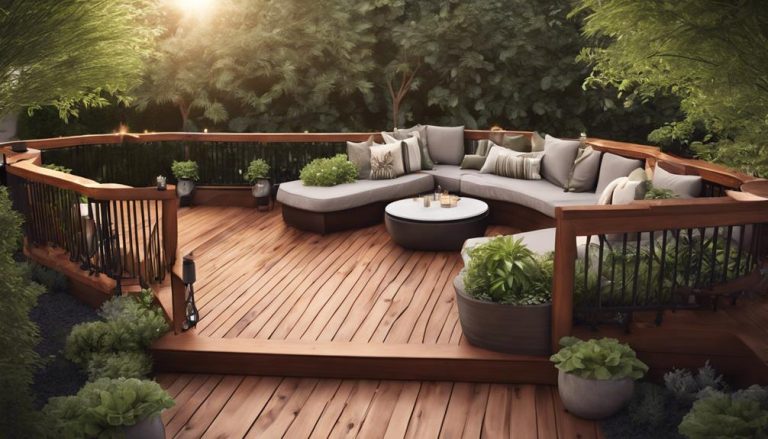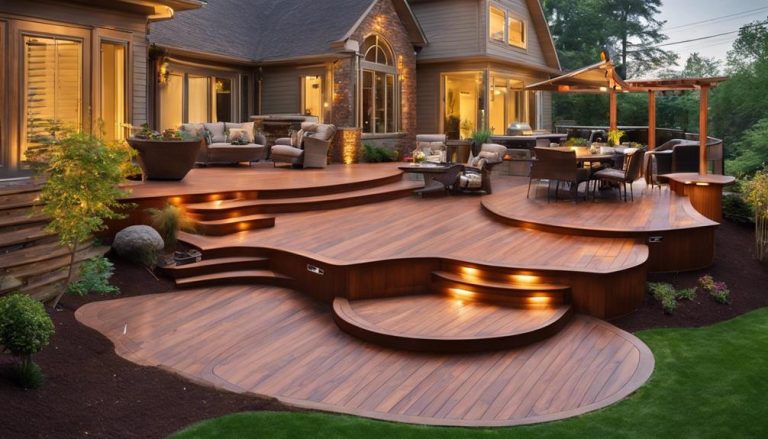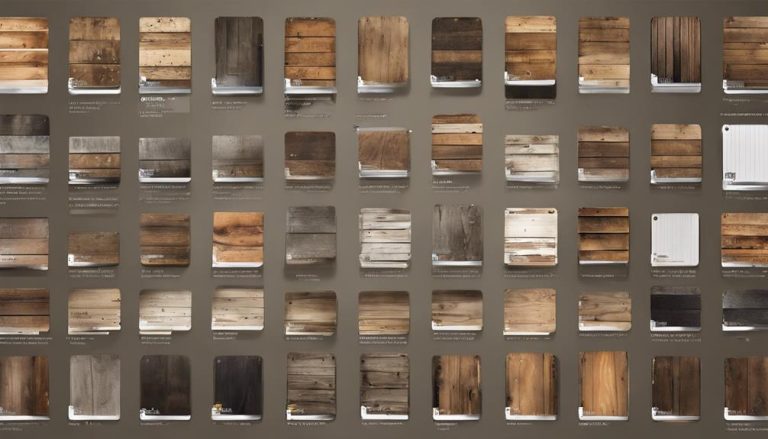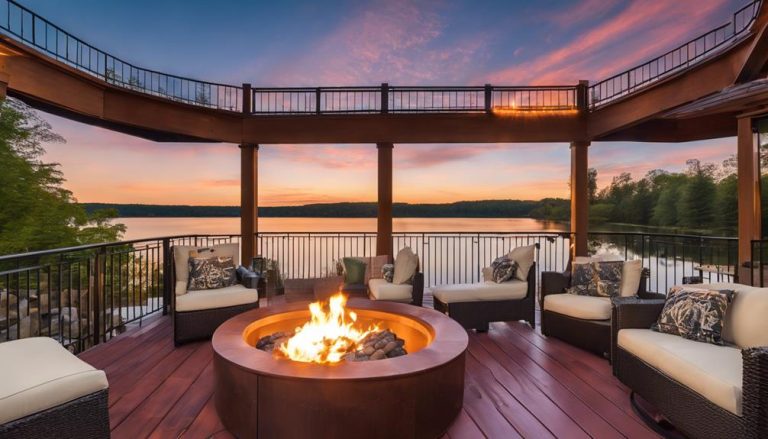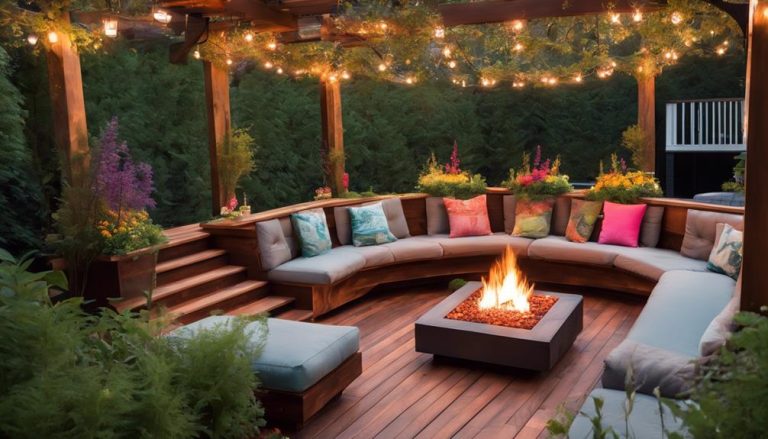How to Choose the Right Materials for Your Custom Deck
Choosing the right materials for a custom deck involves weighing several critical factors. Durability is paramount, with options like pressure-treated wood offering a 15+ year lifespan and high-end composites extending durability up to 30 years. Aesthetic appeal includes considerations of color, texture, and design versatility to guarantee visual harmony with your home's architecture. Environmental implications should also be considered by opting for sustainable materials such as FSC-certified wood or recycled composites. Additionally, the materials' resistance to weather conditions, UV exposure, and moisture profoundly affects maintenance needs and longevity. Understanding these facets confirms an informed decision on your decking project.
Deck Builder Highlights
- Assess material durability for resistance to environmental stressors like UV, moisture, and temperature fluctuations.
- Ensure aesthetic harmony between decking materials and home architecture for visual appeal.
- Select eco-friendly materials like recycled composites or FSC-certified wood to reduce environmental impact.
- Consider long-term cost efficiency and maintenance when choosing between composite and pressure-treated wood options.
- Factor in climate-specific weather resistance needs, such as moisture control and UV protection, for durable decking.
Material Selection Importance
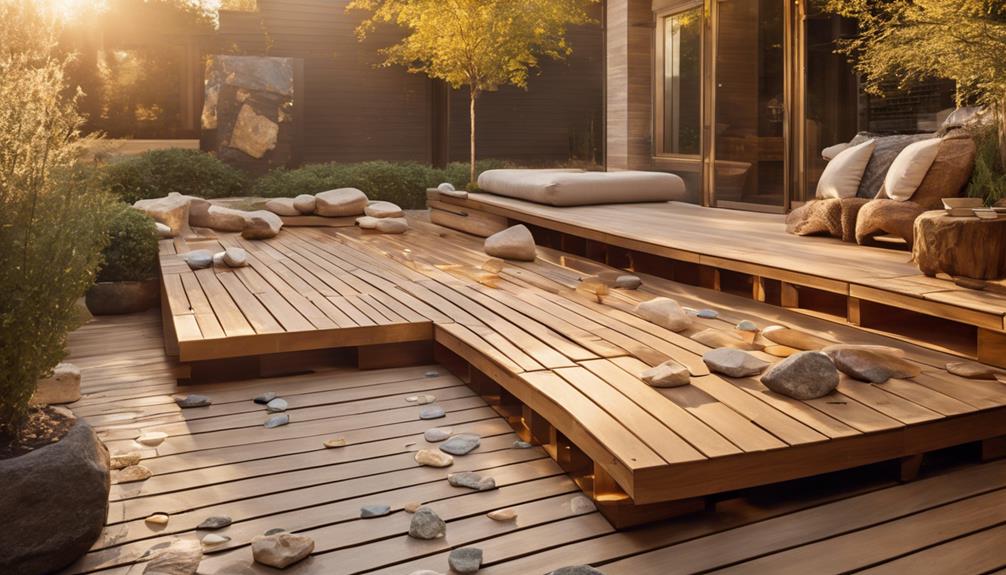
Selecting the right materials for a custom deck is pivotal, as it not only determines the structure's durability and longevity but also influences its aesthetic appeal and environmental impact. Advanced composite materials and high-quality woods offer varying degrees of resistance to weathering and wear, enabling homeowners to tailor decks to specific aesthetic preferences and maintenance capacities.
Additionally, personalized material selection can facilitate seamless deck-home aesthetic integration, enhancing both beauty and functionality. Moreover, choosing eco-friendly options contributes positively to environmental preservation, underlining the importance of integrating sustainability into material selection decisions.
Durability and Longevity
When building a custom deck, the durability and longevity of the materials used are paramount considerations. The life of a deck depends largely on the ability of the selected materials to withstand environmental stressors, such as UV exposure, moisture, and temperature fluctuations. Durable materials guarantee the deck can endure daily wear without succumbing to premature degradation, which is crucial for a safe and low-maintenance investment.
Material selection starts with understanding the properties of various options. Pressure-treated wood, a popular choice, is infused with preservatives that protect against rot and insect damage, offering a lifespan extending beyond 15 years with proper maintenance. Composite decking, an amalgamation of wood fibers and plastic, resists fading, staining, and mold better, often surpassing traditional wood's longevity with minimal upkeep. Some high-end composites even promise durability reaching up to 30 years.
Hardwoods such as Ipe or Teak, known for their innate strength and resistance to decay, require scheduled maintenance to retain their natural allure but promise a lifespan of several decades. Carefully considering each material's durability metrics against local climate conditions, expected foot traffic, and maintenance capabilities will aid homeowners in selecting the most enduring choice for their custom decking project.
Aesthetic Appeal Choices
Aesthetic appeal is a pivotal element in the selection of deck materials, as it directly influences the visual harmony with the surrounding environment. When choosing materials, one must prioritize not only functionality but also the inherent visual characteristics they bring to an outdoor space. The stylistic coherence of the deck with the existing architectural elements of your home elevates the overall design, contributing to a seamless migration from indoor to outdoor living spaces.
Selecting the right materials for your deck involves several critical considerations:
- Color Variety: Different materials, such as hardwoods and composite decking, offer a range of hues, allowing for personalized color schemes that complement the environment.
- Texture and Finish: From the rustic charm of natural wood grains to the sleek finish of composites, the choice of texture can drastically impact the deck's tactile and visual attraction.
- Design Versatility: Consider how the material's flexibility supports varying design patterns, such as herringbone or diagonal planking, enhancing aesthetic complexity.
- Compatibility with Accessories: Ensure materials can be easily accessorized with railings, built-in seating, or planters to create a cohesive look.
Environmental Impact Considerations
Considering the visual appeal alongside environmental impact adds depth to the decision-making process for deck materials. Selecting materials that harmonize with the environment not only contributes to sustainability but also reflects a commitment to eco-friendly practices. Opting for sustainable materials such as certified wood, recycled composites, or natural stones can drastically reduce the ecological footprint of your project.
Certified woods, like those endorsed by the Forest Stewardship Council (FSC), guarantee that the timber is sourced from responsibly managed forests, promoting biodiversity and forest health. Recycled composite decking, made from reclaimed wood fibers and plastics, offers a durable and low-maintenance alternative while preventing waste from populating landfills.
Additionally, incorporating natural stones such as slate or granite, which require minimal processing and maintenance, further economizes energy usage. Furthermore, selecting local materials can minimize transportation emissions, adding another layer of environmental responsibility.
Each choice should align with broader ecological goals and personal preferences, enabling homeowners to enjoy a beautiful, functional outdoor space without compromising on sustainability. By prioritizing these considerations, a custom deck transcends mere aesthetics and functionality, embodying an environmentally conscious lifestyle that benefits both the individual and the planet.
Benefits
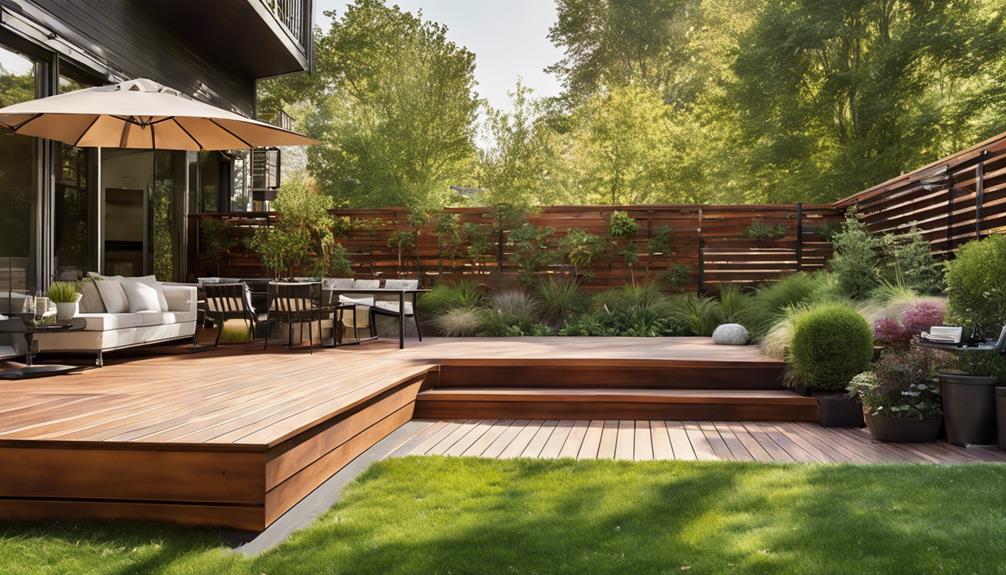
Selecting materials for a custom deck presents several benefits that can drastically improve the value and enjoyment of outdoor spaces. To begin with, durable materials with low maintenance requirements contribute not only to the longevity of the deck but also to reduced upkeep costs over time. Investing in materials like cedar's natural resistance to rot and decay secures a lasting and hassle-free outdoor living space.
Additionally, modern material options offer eco-friendly solutions without compromising aesthetic versatility, enabling homeowners to achieve a harmonious blend of visual appeal and cost-efficiency while aligning with both environmental responsibility and budgetary constraints.
Durability and Maintenance Needs
The longevity of your deck hinges substantially upon the materials selected, making durability and maintenance paramount considerations in your decision-making process. Opting for materials with robust durability not only extends the life of the deck but also guarantees it withstands weather elements, daily wear, and occasional mishaps. The maintenance needs of each material vary, impacting the time and effort required for upkeep and possibly influencing long-term satisfaction with your choice.
Selecting the right material involves analyzing several critical aspects, such as:
- Material Composition: Some materials, like high-grade treated wood or composite, are specifically engineered for longevity, incorporating resistance to decay and insect damage.
- Weather Resistance: Materials that resist moisture, UV rays, and temperature fluctuation can drastically reduce maintenance demands by preventing rot, fading, and warping.
- Ease of Maintenance: Choices like PVC or composite decking might require only occasional washing, whereas wood may need periodic sealing or staining to maintain its appearance and integrity.
- Cost of Upkeep: Evaluate your budgetary constraints, as some materials might require specialized cleaners or more frequent treatment, influencing maintenance expenditure over time.
Eco-Friendly Material Options
As you weigh the durability and maintenance of your decking materials, the environmental impact of your choices can also play a vital role in decision-making. Eco-friendly materials, gaining popularity for their sustainable benefits, present a compelling choice for homeowners seeking to minimize their ecological footprint. These materials, such as composite decking composed of recycled wood fibers and plastics, offer substantial environmental advantages by diverting waste from landfills and reducing the demand for virgin materials.
Bamboo is another sustainable alternative, renowned for its rapid growth and renewability. Unlike traditional hardwoods, which can take decades to mature, bamboo reaches maturity in just a few years, providing a robust, biodegradable option. Additionally, sustainably sourced wood certified by the Forest Stewardship Council (FSC) ensures that forest ecosystems remain viable and contributes to responsible forestry practices.
Reclaimed materials, often salvaged from deconstructed buildings, provide a unique aesthetic while mitigating environmental impact by repurposing existing resources. The emphasis on reducing waste in production, lower lifecycle carbon emissions, and promoting responsible material sourcing makes eco-friendly decking a forward-thinking choice. With these options, homeowners can greatly lessen the environmental toll of their decking project while still achieving a beautiful and functional outdoor space.
Aesthetic Versatility and Appeal
A key benefit of custom decking is its aesthetic versatility, allowing homeowners to tailor their spaces to fit a wide range of design preferences and styles. Custom decks provide a platform to experiment with diverse materials such as natural woods, composites, or even metals that enhance the visual appeal of outdoor environments. With an array of colors, textures, and finishes available, creating a deck that complements the architectural style of a home or personal taste becomes a seamless endeavor.
To maximize the aesthetic versatility of a custom deck, consider these factors:
- Material Selection: Opt for materials that harmonize with the existing landscape and architectural features, allowing the deck to become an extension of your living space.
- Color Coordination: Choose hues that match or contrast with your home's exterior walls or interior furnishings, fostering an inviting conversion between indoors and outdoors.
- Texture Variety: Incorporate textures like smooth or rustic finishes, which can add depth and interest to the deck's appearance while reflecting personal style.
- Design Elements: Incorporate features such as built-in planters, benches, or unique railing designs, adding functional beauty and personal flair to your outdoor retreat.
This carefully curated blend of materials and design elements not only enlivens the outdoor setting but also enhances the property's overall aesthetic value.
Cost-Efficiency and Budgeting
While the aesthetic appeal of custom decking is undeniable, understanding the cost-efficiency and budgeting aspect is crucial for homeowners seeking both beauty and value. An effectively managed budget not only guarantees the financial feasibility of a project but also facilitates the selection of materials that offer longevity and minimal maintenance, ultimately optimizing return on investment. Careful consideration of cost against benefits can prevent unexpected expenditures and aid in maintaining financial equilibrium.
Composite decking, for instance, may present a higher initial outlay than traditional wood. However, its inherent resistance to rot, fading, and insect damage reduces long-term maintenance costs, rendering it a prudent choice in terms of durability and sustainability. Pressure-treated wood, while less costly upfront, may require regular upkeep and replacement, influencing overall lifecycle expenses.
To develop a cost-efficient plan, it is advisable to engage in extensive comparisons of material prices and to seek estimates from multiple suppliers. Additionally, factoring in installation costs, as labor can significantly impact the total budget, will contribute to a more informed decision. Through meticulous planning and detailed budgeting, homeowners can achieve a harmonious balance between the allure of their custom deck and its economic viability.
Weather Resistance Considerations
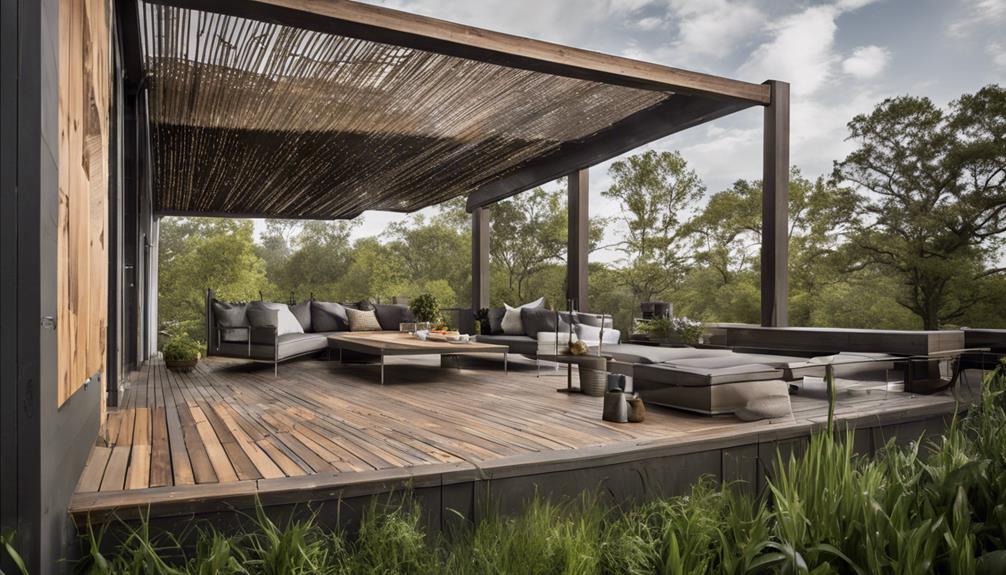
When selecting materials for a custom deck, it is vital to account for their capacity to withstand various weather conditions, which can significantly impact durability and maintenance requirements. The table below provides a quick comparison of how different materials respond to climate influences, the necessity for UV protection, and strategies for moisture control. Understanding these factors can guide homeowners in making informed decisions that align with both aesthetic preferences and practical needs for long-term resilience.
| Material | UV Protection Needed | Moisture Control Strategy |
|---|---|---|
| Wood | High | Regular sealing |
| Composite | Moderate | Built-in resistance |
| PVC | Low | Excellent drainage design |
Climate Impact on Materials
Understanding how climate affects material choices is essential in ensuring the longevity and functionality of a custom deck. Different climates impose varying demands on deck materials, making it important to select those that can withstand specific environmental stressors.
For instance, regions prone to heavy rainfall demand materials with exceptional water resistance, whereas areas with significant seasonal temperature fluctuations require options that can endure thermal expansion and contraction. Aspects such as humidity, precipitation, and temperature extremes are crucial considerations for selecting appropriate materials.
To aid in your decision-making process, consider the following important factors regarding climate impact on materials:
- Moisture Resistance: In humid or rainy areas, opting for materials with high water resistance is crucial to prevent mold, rot, and decay over time.
- Thermal Stability: In regions experiencing significant temperature changes, select materials that accommodate thermal movement, reducing risks of warping or cracking.
- Salt Tolerance: Near coastal areas, materials resistant to salt-induced corrosion are essential for long-term durability and preventing material degradation.
- Frost Resilience: In colder climates, it is imperative to use materials that can withstand freeze-thaw cycles without succumbing to structural damage.
UV Protection Importance
Sunlight, with its relentless UV rays, poses a significant threat to the materials used in custom deck building. These rays can cause deterioration, fading, and structural weakness over time, necessitating careful consideration of UV protection when selecting materials for your deck. Such environmental exposure not only compromises the aesthetic appeal of the deck but also impacts its longevity and safety.
To mitigate these adverse effects, selecting materials known for their UV resistance is paramount. For instance, composite decking options often incorporate UV inhibitors in their formulation, providing an added layer of protection against sun damage. Similarly, hardwoods such as ipe and teak have inherent oils that offer natural resistance to UV degradation. Pressure-treated woods sometimes receive treatments designed to enhance UV resistance, though their effectiveness can vary.
Additionally, applying UV-resistant finishes or sealants can further protect the deck's surface, prolonging its lifespan and maintaining its original appearance. It is essential to regularly maintain these protective coatings, as their effectiveness diminishes with time and environmental exposure. Selecting materials and finishes that emphasize UV resilience guarantees your custom deck remains visually appealing and structurally sound despite the harsh realities of continuous sun exposure.
Moisture Control Strategies
Decks are constantly exposed to various weather elements, making moisture control an essential factor in material selection. While choosing the right materials, consider those that offer resistance to water damage and minimize the risk of warping, swelling, or mildew. Opt for solutions that enhance longevity and sustainability, given the geographical and climatic conditions of your locality.
To ensure effective moisture control, consider the following strategies:
- Pressure-treated wood: Designed specifically to withstand moisture-related issues, pressure-treated wood is infused with chemicals that repel water and resist decay. This material is a popular choice due to its affordability and durability under moist conditions.
- Composite decking: Composites combine wood fibers and plastic, producing a dense material resistant to water absorption and decay. This option reduces maintenance needs while providing a natural look.
- Proper ventilation: Adequate ventilation beneath the deck is pivotal for preventing moisture accumulation, which can lead to mold or wood rot. Incorporate spacing between deck boards to allow for effective air circulation.
- Water-repellent finishes: Applying sealants and water-repellent coatings enhance the natural moisture resistance of the chosen decking material, acting as an additional layer of protection.
Employing these strategies helps maintain the deck's structural integrity and aesthetics over time.
Decks FAQ
How Does the Cost of Materials Affect the Overall Budget for a Deck Project?
The cost of materials markedly influences a deck project's overall budget, dictating potential design choices, quality, and longevity. Selecting cost-effective yet durable materials is vital for balancing initial expenditures with long-term maintenance and aesthetic satisfaction.
Are Certain Materials More Eco-Friendly or Sustainable for Deck Construction?
Yes, materials such as recycled composites, responsibly harvested wood, and bamboo are considered more environmentally friendly for deck construction. These options minimize waste, reduce ecological impact, and often offer comparable durability and aesthetics to conventional choices.
What Maintenance Requirements Come With Different Decking Materials?
Different decking materials have varying maintenance needs. For instance, wood requires regular sealing and staining, whereas composite decking demands minimal upkeep beyond occasional cleaning. Other options like PVC or aluminum provide durability with reduced maintenance, enhancing long-term value.
How Do Different Materials Influence the Aesthetic and Design Possibilities of a Deck?
Different decking materials greatly impact aesthetic appeal and design versatility. Wood offers a classic look, composites provide diverse textures and colors, while metal and concrete enable modern, sleek designs, each influencing the overall ambiance and visual harmony of the space.
Can Decking Materials Affect the Resale Value of a Home?
Yes, decking materials can extensively influence a home's resale value. High-quality, durable materials, such as composite or hardwood, often enhance aesthetic appeal and longevity, potentially increasing buyer interest and maximizing return on investment during sale.



